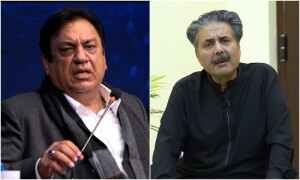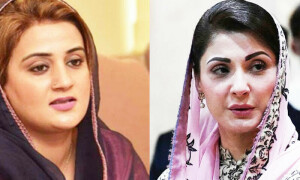THE excitable lot has told us it’s the Clash of the Titans. Today will change everything. The sceptical lot has told us it doesn’t matter. Today will change nothing.
So let’s forget about today and look to the future. Say, 2018. There’s a proper election scheduled for then, around late summer.
That may seem a while away, but it’s creeping nearer. And, the closer we get to it, a funny thing may be happening.
First, though, conventional wisdom. 2018 will be a two-horse race and the battleground will again be Punjab. PML-N v PTI — may the best man win.
By now, here in 2015, it’s become fairly obvious: the PML-N is about as rubbish at governing as the PPP was.
PML-N will have the advantage because, well, it’s delivered a bunch of things and Punjab is super fond of Mian Sahib, even if it hasn’t quite warmed to the younger Sharif.
PTI will have learned from 2013 and will position itself to grab a bunch of seats, but it will still fall short. Ultimately, the party won’t have the machine to move it up from second to first.
That’s the conventional wisdom and it seems fairly reasonable. But let’s try something else.
One full term and a peaceful transition in 2013 increased the odds of a second full term. So a second full term followed by a peaceful transition in 2018 should make a third consecutive full term even more likely.
2018 should take us to 2023. And that’s when things start to get a bit complicated. By 2023, if conventional wisdom prevails, Punjab would have been ruled by the PML-N for 15 straight years.
Fifteen years is dictator terrain. Hell, it’s beyond dictator — Ayub lasted a shade under 11 years, Zia a smidge more than 11, Musharraf just under nine.
If Punjab re-elects PML-N in the centre in 2018, it will also have re-re-elected the PML-N in Punjab. Not even a King’s party has managed that.
And that changes the equation a little. In ordinary times, the Punjabi voter would have a straightforward job: decide if a government’s performance over the previous five years means it deserves another five.
In PML-N times, in 2018, the voter will also have to figure out if he’s OK with electing what would effectively be a permanent government.
When the military is chucking you in and out and terms aren’t being completed, a two-term prime minister and a three-term CM isn’t such a big deal.
But a four-term, two-full-term PM and a five-term, three-consecutive-term CM elected freely and uninterrupted by the public itself — to be convinced, the voter may want something more.
Something more that the PML-N may not have.
By now, here in 2015, it’s become fairly obvious: the PML-N is about as rubbish at governing as the PPP was.
The PPP knew they were rubbish, didn’t care that they were rubbish, and decided early on to enjoy themselves as much as they could for as long as they could.
From there was born the legend of The Worst Government the Country Has Ever Had, 2008-2013. Sindh, poor, pitiable Sindh, continues to suffer.
The PML-N was supposed to be different. It was supposed to be The Best Civilian Government Ever, 2013-2018. Efficiency, ideas, energy — turnaround was coming our way.
But the N-League has flunked every governance test thrown its way. Sure, the Metro is nice and a bunch of roads are getting built, but the positive externalities aren’t endless.
One or two Metros don’t translate into better transport everywhere. A few big roads don’t mean connectivity for the population at large. And, really, the bling effect wears off.
What was cool and fascinating five years ago leaves people cool and un-fascinated if simply more and more of the same is offered.
Now, back to the present. Everything — and it is no exaggeration to say everything — that is going well for the N-League comes down to two things: low oil prices and low commodity prices.
It’s a multi-billion-dollar bonanza that is the exact opposite of what the PPP was pummelled by early in its term — a spike in oil and commodity prices topped off by a global liquidity crunch.
Take away the bonanza that has come the N-League’s way and minus the pummelling that the PPP took early on and what’s left is a sad, rather incontrovertible truth:
The PML-N is about as rubbish at governing as the PPP was.
Ah, but at least there’s the corruption differentiator, you’re thinking. Anything is better than the PPP.
Possibly. The smash-and-grab style of the PPP and the continuing depredations in Sindh would make a bandit blush. But there’s a quiet bubbling of rumour and speculation around the PML-N too.
Away from the Nandipur turmoil and beyond rules being bypassed in haste, not greed, there’s all kinds of talk seeping out. Of front companies and hidden ownerships and dodgy interests.
And far too much of it is leading back to the same names, in government and outside, that are dominating the energy and electricity landscapes in the PML-N era.
Three more years is a long time. Long enough for oil and commodity prices to swing upwards again. Long enough for tales of pelf and corruption to slime their way into public view.
Long enough for things to go pear-shaped again. And long enough for folk in Punjab to wonder: maybe we should give someone else a chance.
The someone else? That would be the PTI.
The writer is a member of staff.
Twitter: @cyalm
Published in Dawn, October 11th, 2015
On a mobile phone? Get the Dawn Mobile App: Apple Store | Google Play











































